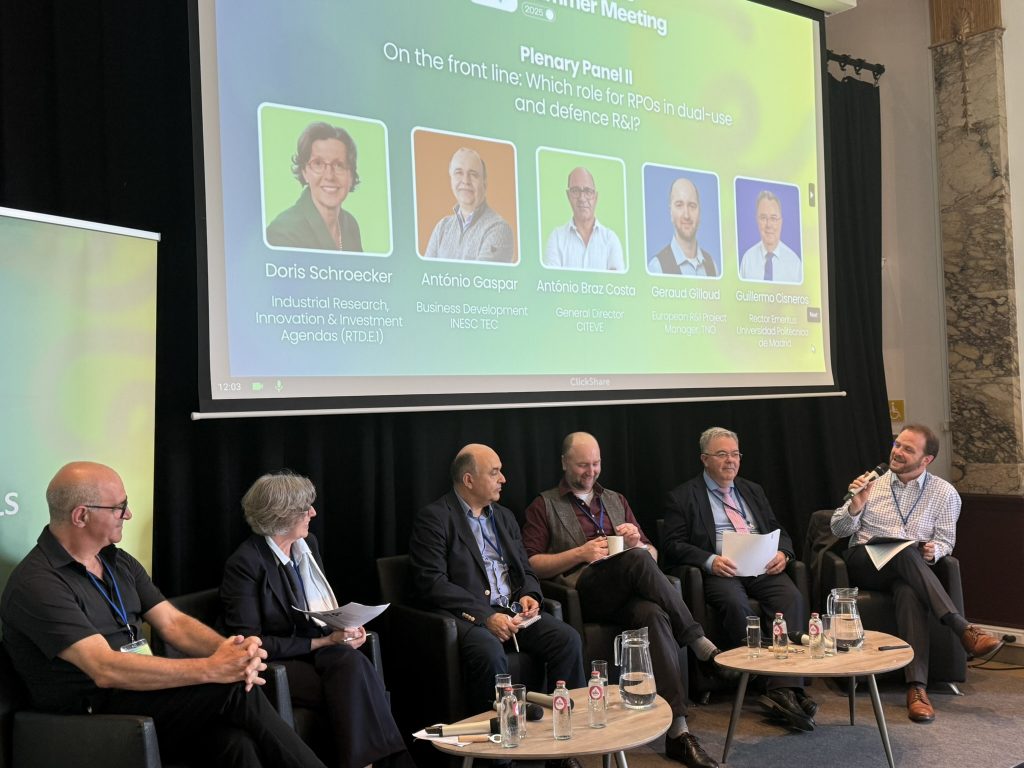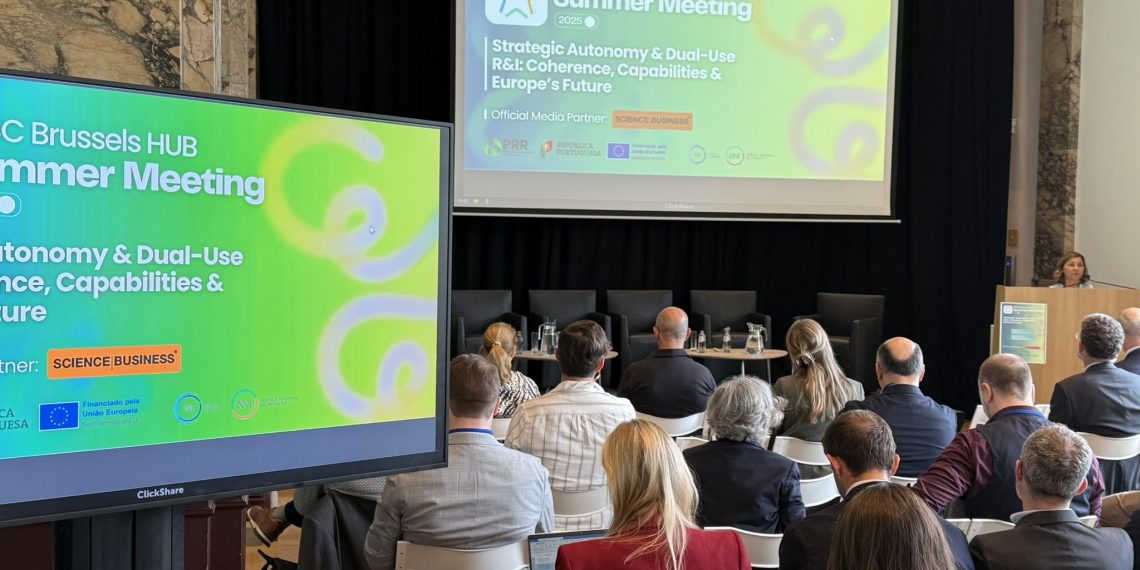Brussels hosted two days of discussion involving policymakers, European Commission representatives, research and development (R&D) centres, and industrial stakeholders, focusing on the future of science and technology for a more resilient, autonomous, and sustainable Europe. Exploring the theme Strategic Autonomy & Dual-Use R&I: Coherence, Capabilities & Europe’s Future, the INESC Brussels HUB Summer Meeting 2025 brought together over 140 participants on June 25 and 26.
One of this year’s strategic partners was PLANAPP – Centre for Planning and Evaluation of Public Policies – a central government body with administrative autonomy; it plays a key role in supporting the strategic planning of governmental priorities, ensuring policy coherence across sectors and evaluating implementation and impact. Other key players included the Foresight Unit of the Joint Research Centre (JRC) and the European Parliamentary Research Service (EPRS), key players in promoting anticipatory governance and long-term thinking within the institutions of the European Union. RAND Europe also joined to reflect on R&I in defence, and the collaboration between these four entities represented a unique opportunity to bridge national and European approaches to foresight, policy planning, and strategic coherence.
This year’s edition focused on structural themes like the coherence of support programmes for dual-use and defence-related R&I, the very concept of dual-use and the practical implementation to promote strategic autonomy, and the future outlook: how these elements could be incorporated into the next Multiannual Financial Framework (2028–2034) and the forthcoming EU Framework Programme for Research and Innovation (FP10). Other key topics for the R&I community included knowledge security, characterisation and distribution of research and innovation capabilities across the EU, and their relevance for Europe’s autonomy and competitiveness.
INESC TEC took an active role throughout the meeting, participating in panel discussions and networking sessions, reaffirming the status as one of Europe’s leading science and technology interface institutions.
Key Objectives of the Discussion
Taking place at a crucial time for the European research and innovation system – marked by intensified geopolitical tensions, rapid technological transitions, and increasing demands for industrial and technological sovereignty – the 2025 INESC Brussels HUB Summer Meeting aimed to:
- explore coherence among EU funding programmes crucial for strategic autonomy and resilience, such as FP10, DF2, EDIS, and Digital Europe;
- highlight the role of RTOs (Research and Technology Organisations), universities, and other research institutions within the dual-use and defence R&I ecosystem, advocating for greater visibility and involvement;
- frame dual-use technologies as strategic enablers of European resilience, industrial decentralisation, and preparedness in key areas like energy, cybersecurity, health, mobility, and civil protection;
- contribute to shaping EU approaches to knowledge security, addressing the growing tension between open science and the protection of critical technologies;
- support a shared understanding of roles and responsibilities across the European R&I system to improve programme design, ensure funding complementarity, and maximise collaborative potential;
- strengthen the position of the INESC ecosystem and the broader European research community as key contributors to R&I development.

INESC TEC’s participation
Under the overarching theme “Strategic Landscape and Systemic Challenges”, the first day featured a range of panel discussions with contributions from several INESC TEC researchers.
The first intervention was by António Gaspar from INESC TEC’s business development area, who participated in a panel on the role of RTOs in dual-use and defence R&D. Moderated by Simon Pickard of Science Business (the event’s media partner), the panel included Doris Schroecker (Head of Unit for Industrial Research, Innovation & Investment Agendas), António Braz Costa (Director-General of CITEVE), Geraud Gilloud (TNO), and Guillermo Cisneros (Dean Emeritus of the Polytechnic University of Madrid). António Gaspar focused on several proposals to reinforce the role of RTOs in future defence programmes.
A later session titled “Foresight Session – Forewarned is forearmed: How to anticipate the future of defence and dual-use?” was moderated by Simon Pickard and included panellists Elsa Picão (PLANAPP), João Farinha (JRC), Henri vas Soest (RAND Europe), and Antoine Cahen (EPRS).
On the second day, INESC TEC researchers Hugo Paredes, Ignacio Gil, and Nuno Cruz participated in various thematic sessions.
Hugo Paredes, who leads the Human-Centered Computing and Information Science area at INESC TEC, joined the session “Health, Cyber, and Sensors for Societal Resilience”. Under the theme “Mind-Aware, Mission-Ready”, he presented ongoing research into personalised health solutions, including internet-based treatments, secure data storage, harmonised sharing, and privacy-preserving analysis. He also discussed INESC TEC’s decade-long work in mental health software systems, now focused on defining cognitive profiling for ongoing depression pre-assessment. Other topics included human-centred AI supervision, the challenge of integrating non-deterministic AI components into complex software systems, and multisensory virtual environments for Human-Technology Symbiosis.
Ignacio Gil, researcher in power & energy systems at INESC TEC, and Nuno Cruz, coordinator of the Institute’s robotics and autonomous systems area, contributed to the session “Robotics, Power Systems and Autonomy – Strategic Tech for Civil and Defence”.
Ignacio Gil presented under the theme “Energy, Power Systems and Autonomy – Strategic Tech and Critical Infrastructures”, exploring how AI-driven smart grids and digitalisation can enhance Europe’s energy transition and grid resilience amid ageing infrastructure and rising demand. He focused on resilient grid design, the return of DC systems, and smart substations leveraging real-time data, AI, and cybersecurity. Gil also noted a geopolitical shift in EU priorities from “climate first” to strategic autonomy, industrial competitiveness, and energy security, proposing solutions such as web-of-cells for decentralised control and interoperable recommender systems. He concluded with calls for policy alignment, investment in digital infrastructure, and next-generation architecture to support a clean, secure, and adaptable European power grid.
Nuno Cruz addressed emerging challenges in marine robotics and the strategic importance for civil and defence missions, including environmental monitoring, infrastructure protection, and surveillance – exemplified by INESC TEC-led projects SEAGUARD and NAUTILUS. He stressed the need for mechanisms that accelerate the adoption of autonomous robotic technologies and the role of research centres as drivers of innovation. “Marine robotics is now a strategic technology for addressing both civil and defence challenges – from environmental monitoring to the protection of critical infrastructure. We need mechanisms to scale up these solutions and reinforce Europe’s leadership in technological innovation,” he said.
The event concluded with a plenary session titled “The road to FP10 – Can Europe build the right foundations for its R&I future?”, moderated by Simon Pickard. Panellists included Manuel Aleixo (Cabinet of Commissioner Ekaterina Zaharieva), Carla Matias dos Santos (Advisor at Portugal’s Permanent Representation to the EU), Verena Fennemann (Head of Fraunhofer’s Brussels Office), and Mattias Bjornmalm (Secretary-General of CESAER).
Key Takeaways
INESC TEC Chairman and INESC Brussels HUB Vice-President João Claro led the event’s closing session, highlighting growing clarity in the EU’s research and innovation agenda in defence and dual-use domains.
According to João Claro, “there is an urgent need to reduce fragmentation and build critical mass, namely by combining research excellence with stronger roles for research-performing organisations in collaborative roadmapping, orchestration, and mission delivery”. He identified institutional preparedness, value chain scale-up, and strategic manufacturing capacity as emerging priorities essential for developing dual-use and defence capabilities.
João Claro emphasised that while many elements are already in place and key priorities have been outlined, the structural challenges ahead are becoming clearer. “We hope this event has helped each of us reinforce our commitment to a coherent and ambitious European defence and dual-use R&I effort and brought further clarity to the path we must follow,” he concluded, thanking all participants and the teams involved in organising the meeting.
The researchers mentioned in this news piece are associated with INESC TEC, Faculty of Engineering of the University of Porto (FEUP), Porto School of Engineering (ISEP) and the University of Trás-os-Montes e Alto Douro (UTAD).



 News, current topics, curiosities and so much more about INESC TEC and its community!
News, current topics, curiosities and so much more about INESC TEC and its community!